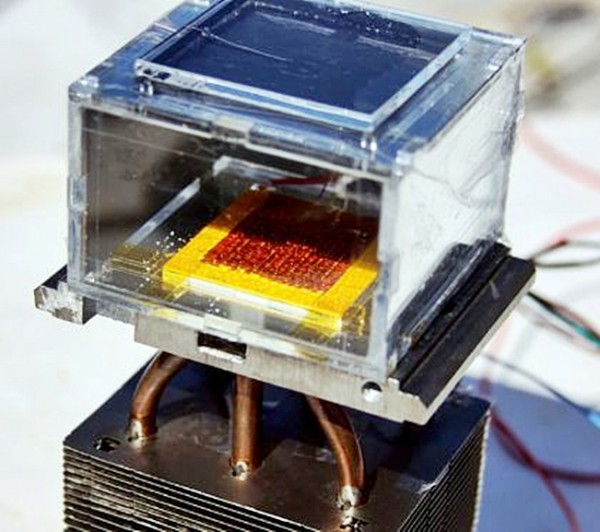Solar Water Harvester Produces Water from Air
| Arthur Dominic Villasanta | | Apr 14, 2017 04:32 AM EDT |
(Photo : MIT) Water harvester built at MIT with MOFs from UC Berkeley.
A solar-powered "water harvester" that produces water from air, including the dry air in desert climates, has been jointly developed by teams from the Massachusetts Institute of Technology (MIT) und the University of California, Berkeley (UC Berkeley).
Powered by sunlight, the harvester can pull liters of water from low-humidity air over a 12-hour period each day in conditions as low as 20 percent humidity, a level common in arid areas.
Like Us on Facebook
The prototype was built at MIT using a special material -- a metal-organic framework (MOF) -- produced at UC Berkeley.
Under conditions of 20 to 30 percent humidity, the prototype was able to pull 2.8 liters of water from the air over a 12-hour period, using one kilogram of MOF. Rooftop tests at MIT confirmed the device works in real-world conditions.
"This is a major breakthrough in the long-standing challenge of harvesting water from the air at low humidity," said Omar Yaghi, one of two senior authors of the paper, who holds the James and Neeltje Tretter chair in chemistry at UC Berkeley and is a faculty scientist at Lawrence Berkeley National Laboratory.
"There is no other way to do that right now, except by using extra energy. Your electric dehumidifier at home 'produces' very expensive water."
Yaghi said one vision for the future is to have water off-grid, where you have a device at home running on ambient solar for delivering water that satisfies the needs of a household. He said this will be made possible because of this experiment.
"I call it personalized water," he said.
In 2014, Yaghi and his UC Berkeley team synthesized a MOF, which is a combination of zirconium metal and adipic acid that binds water vapor. He teamed-up with Evelyn Wang, a mechanical engineer at MIT, to turn the MOF into a water-collecting system.
Yaghi invented metal-organic frameworks over 20 years ago, combining metals like magnesium or aluminum with organic molecules to develop rigid, porous structures ideal for storing gases and liquids.
Since then, some 20,000 different MOFs have been created by researchers worldwide. Some hold chemicals such as hydrogen or methane.
Tagswater harvester, Massachusetts Institute of Technology, University of California, Berkeley, Omar Yaghi, metal-organic framework, MOF, Evelyn Wang
©2015 Chinatopix All rights reserved. Do not reproduce without permission
EDITOR'S PICKS
-

Did the Trump administration just announce plans for a trade war with ‘hostile’ China and Russia?
-

US Senate passes Taiwan travel bill slammed by China
-

As Yan Sihong’s family grieves, here are other Chinese students who went missing abroad. Some have never been found
-

Beijing blasts Western critics who ‘smear China’ with the term sharp power
-

China Envoy Seeks to Defuse Tensions With U.S. as a Trade War Brews
-

Singapore's Deputy PM Provides Bitcoin Vote of Confidence Amid China's Blanket Bans
-

China warns investors over risks in overseas virtual currency trading
-

Chinese government most trustworthy: survey
-

Kashima Antlers On Course For Back-To-Back Titles
MOST POPULAR
LATEST NEWS
Zhou Yongkang: China's Former Security Chief Sentenced to Life in Prison

China's former Chief of the Ministry of Public Security, Zhou Yongkang, has been given a life sentence after he was found guilty of abusing his office, bribery and deliberately ... Full Article
TRENDING STORY

China Pork Prices Expected to Stabilize As The Supplies Recover

Elephone P9000 Smartphone is now on Sale on Amazon India

There's a Big Chance Cliffhangers Won't Still Be Resolved When Grey's Anatomy Season 13 Returns

Supreme Court Ruled on Samsung vs Apple Dispute for Patent Infringement

Microsoft Surface Pro 5 Rumors and Release Date: What is the Latest?












